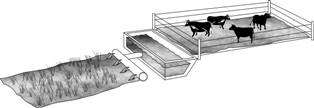Vegetative treatment systems (VTS) have been explored as a manure treatment option for small farms as well as large Confined Animal Feeding Operations (CAFOs).
What Is a Vegetative Treatment System?
Runoff from livestock barnyards and feedlots can kill fish and cause algae blooms in lakes and streams. A Vegetative Treatment System (VTS) can be an economical alternative to retention (holding) ponds for controlling runoff from a livestock waste facility.
A Vegetative Treatment System (VTS) refers to a combination of treatment steps for managing runoff. It treats runoff by settling, infiltration, and nutrient use. Individual components of a VTS include, a settling structure, an outlet structure, a distribution system, and a Vegetative Treatment Area, when put together we consider it a Vegetative Treatment System.
Vegetative Treatment Area
A Vegetative Treatment Area (VTA) is an area of perennial vegetation, such as a grass or a forage. The VTA is used to treat runoff from a feedlot or barnyard. It treats runoff by settling, infiltration, and nutrient use. A VTA is commonly confused with vegetative buffer (or filter) strips. A buffer strip is a narrow strip of vegetation (usually 30-60 feet wide), between cropland and a stream or other surface water. Runoff passes through buffers with some “filtering” of pollutants, but no attempt is made to control solids or flow. A VTS, however, collects runoff from a barnyard or feedlot, separates the solids from the liquids, and uniformly distributes the liquid over the vegetated area. Little or no runoff should leave a VTA.
The first step in a VTS is to collect runoff from a open lot or barnyard area in a sediment settling structure, usually a basin. Such basins are very effective for removing most solids. The runoff then flows into a VTA (Vegetative Treatment Area) whose soil treats and stores the runoff. Once the runoff is in the soil, natural processes allow plants to use the nutrients.
The general idea behind this technology is that the plants will take up the nutrients contained in the runoff and that natural factors will eliminate undesirable components such as pathogens. There are many different types of VTA’s, level, infiltration basins, sloped, sprinkler, dual and multiple systems, etc. To learn more about the different combinations, and when they are appropriate, see VTS System Types and Configurations.
How is a Vegetative Treatment Area Different From a Buffer Strip?
The critical aspect of the VTA is that is has been designed and sized to treat the runoff nutrients generated by the lot–letting runoff flow uncontrolled across the nearest pasture or crop field is not likely to achieve the desired treatment. The runoff needs to be released in a controlled manner. This control is what differentiates a VTA from grass filter/buffer strips. Controls also need to be put in place to eliminate any discharge from the VTA.
Designing a Vegetated Treatment Area
VTA’s must be graded to achieve uniform distribution. To achieve this, the existing landscape will need to be altered (leveled, graded, terraced, etc). If the site requires a great deal of work to create a functional VTA, the costs will obviously be higher than a site that requires only minimal alteration. Essentially, the VTA replaces the holding pond for storing (and utilizing) the nutrients and the liquid volume. In a holding pond this is impounded in a pond, in the VTA, the storage is a fraction of the available water holding capacity in the root zone.
Nitrogen Removal
The percent of the nitrogen removed from the runoff is directly related to the size of the VTA in relation to the size of the feedlot or barnyard as well as the distance that the runoff flows across the VTA. Increases in size of the VTA and flow distance remove more nitrogen. Up to 80% removal can be expected, depending on the design used. Maintaining the system so that the flow is uniform across the VTA, rather than becoming channelized, is also important to the performance of the system. Regular harvesting of the vegetation from the VTA preserves its ability to remove nutrients. Grazing a VTA is not acceptable, as this does not remove nutrients from the system. For more information on technical and design information on VTS, see some outside links to VTS Resources and some frequently asked questions about large CAFO VTS’s.
Phosphorus Removal
Phosphorus removal is directly related to solids removal. One literature review that summarized a large number of research projects, found an average of 70% phosphorus removal. Use of a solids settling basin before the runoff enters the VTA will result in a much lower amount of phosphorus that needs to be treated by the VTA. The settling basin does need to be cleaned out on a regular basis and the material land applied appropriately or utilized in another manner. If solids are not settled out prior to entering the VTA, the maintenance of the VTA itself is increased and the solids have potential to damage the vegetation.
The most common application for VTAs, in the past, have been for smaller, unregulated feedlots. Interest in their use for larger, permitted operations is growing and there is a body of evidence to suggest that a properly engineered and maintained VTS can perform as well as conventional treatments. Their use, as with any other technology is likely to be an individual decision dependent on site specific factors, interests and skills of the operator, and acceptance by regulators.
Need more information?
Read these factsheets, “Got Barnyard Runoff?” and “Need a Vegetative Treatement System for your Lot?”.
In depth planning and design information is available at “Vegetative Treatment Systems Guidance Document”
There are also several Webcasts and Virtual Tours of VTS systems available if you would like to see more in-depth discussions or take a tour of some actual systems.
Page developed and maintained by Chris Henry and Rick Koelsch, University of Nebraska Extension
Page reviewed by: Mark Rice, North Carolina State University


